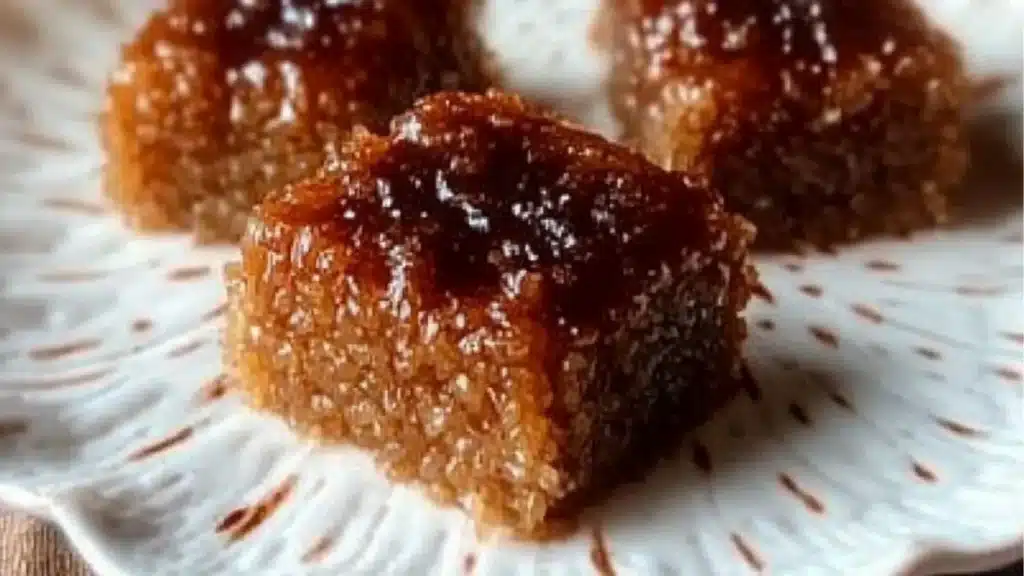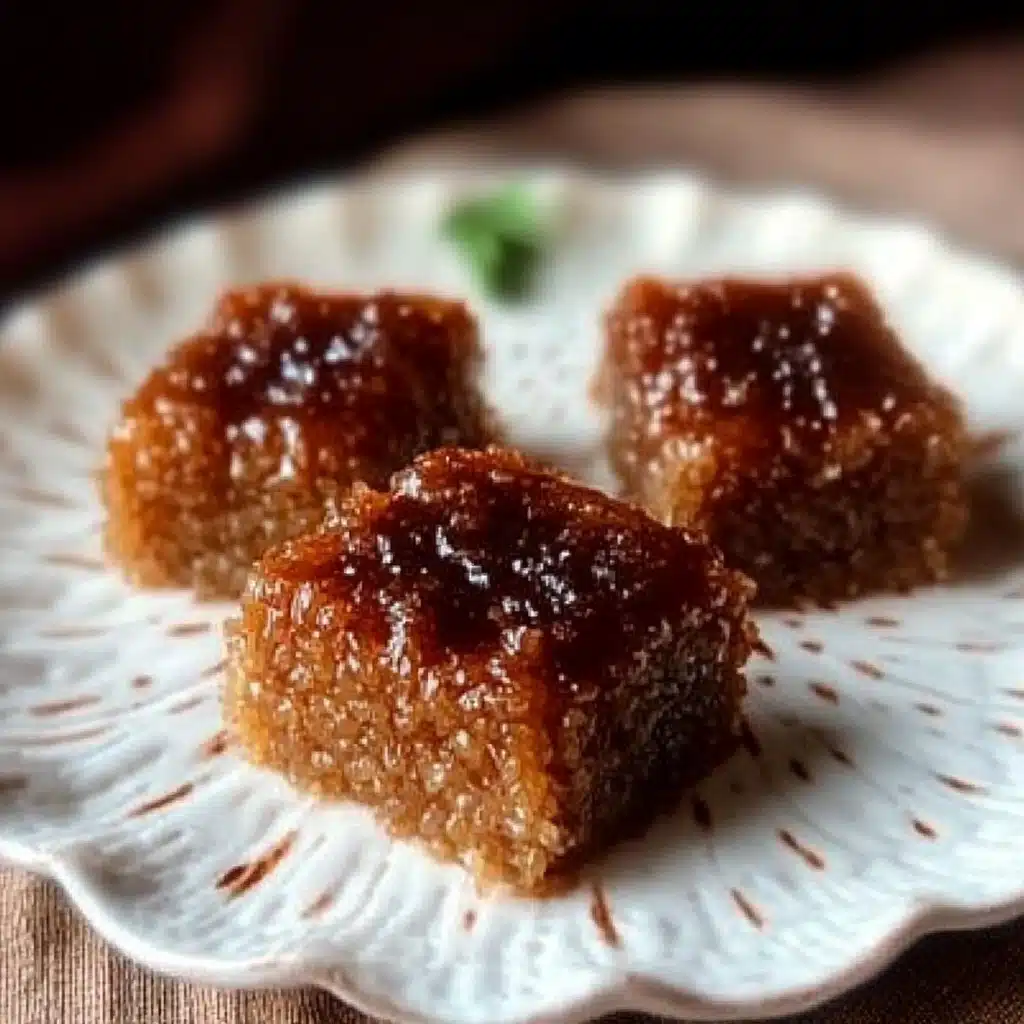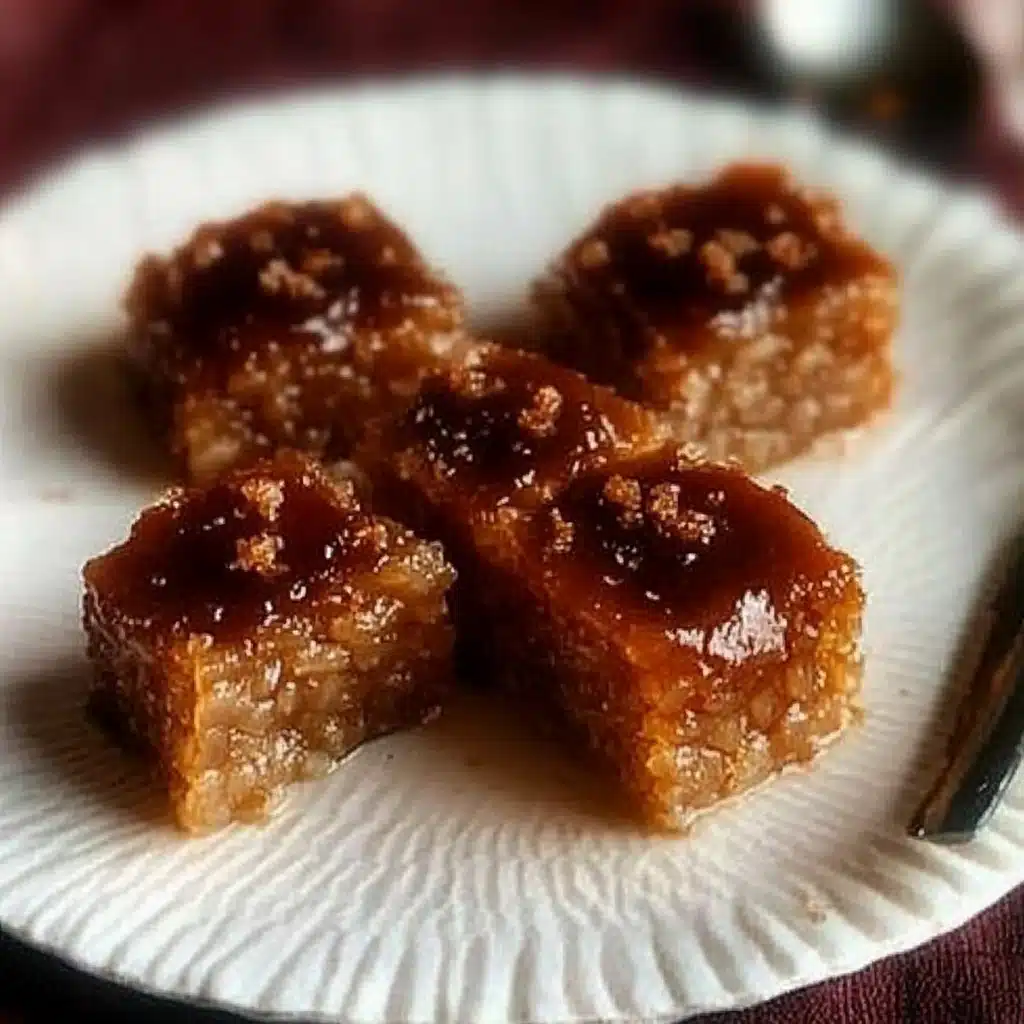Few desserts capture the warmth and spirit of Filipino gatherings like Biko Filipino Sticky Rice Cake. Rich, chewy, and wonderfully fragrant, this traditional treat is made from sticky rice slowly cooked with coconut milk and brown sugar until perfectly caramelized. It’s a dessert that tastes like home — comforting, nostalgic, and deeply satisfying.
Served during celebrations, birthdays, and family reunions, Biko represents love and togetherness in Filipino culture. Each golden slice carries the sweetness of tradition, making it one of the most cherished Filipino Recipes ever created. And the best part? It’s easy to make at home with just a few simple ingredients.
If you love Asian Desserts that combine flavor, texture, and culture, you’ll also enjoy Easy Ube Butter Mochi or Pumpkin Cheesecake Cookies — both are beautiful, chewy, and absolutely delicious.
Table of Contents
What Is Biko? Understanding This Filipino Food Dessert
Biko is a type of Sticky Rice Cake native to the Philippines, typically made with glutinous rice (locally known as malagkit), coconut milk, and brown sugar. The mixture is slow-cooked until thick and sticky, then topped with a sweet layer called latik — a coconut caramel that adds a deep, toasty sweetness.
It’s commonly served on banana leaves for aroma and authenticity, giving the dessert a tropical essence that ties it back to its roots. While every region in the Philippines has its own twist, the foundation remains the same: sticky, sweet, and utterly comforting.
Similar to Pumpkin Cheesecake Truffles, it’s simple but deeply flavorful — proof that the best desserts often come from humble ingredients.
Why You’ll Love This Sticky Rice Cake
Biko is the definition of comfort food. It’s soft, chewy, and rich without being overly sweet. Each bite brings together the creamy depth of coconut milk and the earthy sweetness of brown sugar, creating a flavor balance that’s hard to resist.
- Naturally gluten-free: Perfect for those following clean or Чистое Питание (Clean Eating) diets.
- Simple ingredients: Just rice, coconut milk, and sugar — no fancy tools required.
- Perfect make-ahead dessert: Tastes even better the next day.
- Great for sharing: A staple at Filipino parties, potlucks, and holidays.
- Versatile flavor: Works beautifully with fruits, nuts, or caramel drizzle.
Like Apple Crisp with Oatmeal or Pumpkin Brownies, it’s a dessert that feels homemade and heartwarming.
Ingredients for Biko Filipino Sticky Rice Cake
Here’s everything you need for this easy Dessert Facile:
Main Ingredients
- 2 cups (400g) glutinous rice (malagkit)
- 1 ¾ cups (420ml) coconut milk
- 1 ¼ cups (250g) dark brown sugar
- 1 teaspoon vanilla extract
- Pinch of salt
For the Latik Topping (Coconut Caramel)
- 1 cup (240ml) coconut milk
- ½ cup (100g) brown sugar
Optional Add-ins:
- ½ cup toasted coconut flakes
- Sliced ripe mango for garnish
- Chopped roasted peanuts for texture
This base recipe is vegan and fits well into Receitas Vegetarianas and plant-based meal plans.
Step-by-Step Instructions for Making Biko
Step 1: Cook the Sticky Rice
Rinse the glutinous rice under cold water until the water runs clear. In a pot, combine rice with 1 ½ cups of water. Cook over medium heat until most of the water is absorbed and the rice is just tender — about 10–12 minutes.
The rice should still be slightly firm because it will continue cooking in coconut milk later.
Step 2: Prepare the Coconut Sauce
In a large pan or wok, combine coconut milk, brown sugar, vanilla, and salt. Stir constantly over medium heat until the sugar dissolves and the mixture begins to thicken.
This sweet, creamy sauce is the heart of your Filipino Food Dessert, infusing every grain of rice with rich caramel flavor.
Step 3: Combine Rice and Sauce
Add the cooked rice into the coconut mixture. Stir continuously over low heat for 15–20 minutes until the rice absorbs the sauce and the mixture becomes thick and sticky.
The texture should be cohesive but not runny — it should hold its shape when pressed.
Step 4: Make the Latik Topping
In a separate pan, simmer 1 cup of coconut milk until it reduces and small golden-brown solids form. Stir in brown sugar to create a caramel-like topping. This step adds a nutty aroma and a gorgeous golden glaze to your biko.
Step 5: Assemble
Line a square or rectangular dish with banana leaves or parchment paper. Spread the rice mixture evenly and smooth the surface. Pour the latik topping over the top and spread gently. Let it cool completely before slicing into squares or rectangles.
It’s that simple — a truly Dessert Facile that tastes like hours of effort.
If you enjoy layered or sticky textures, you’ll love Easy Ube Butter Mochi — another chewy, coconut-based delight.
Essential Tools for Preparing Sticky Rice Desserts
- Medium pot or rice cooker
- Non-stick pan or wok
- Wooden spoon or spatula
- Baking dish or tray
- Banana leaves (optional, for authenticity)
- Measuring cups and spoons
Minimal tools, maximum flavor — much like when baking Mini Pumpkin Bread with Cinnamon Swirl.
Tips for Perfect Filipino Biko Texture
- Use real glutinous rice: Regular rice won’t achieve that signature chewiness.
- Don’t rush the caramel: Stir patiently for the right consistency.
- Coconut milk quality matters: Full-fat versions produce richer flavor.
- Let it rest before slicing: Cooling helps the cake firm up.
- Cook low and slow: This dessert rewards patience.
The result? A glossy, chewy Sticky Rice Cake with a perfect balance of sweetness and creaminess.
Common Mistakes to Avoid When Making Asian Desserts
- Using overcooked rice: It can make your biko mushy.
- Too much sugar: Overly sweet syrup can mask the coconut flavor.
- Skipping the salt: A tiny pinch enhances the overall taste.
- Cutting while hot: Always let it set before slicing.
These same tips apply when crafting smooth-textured desserts like Pumpkin Cheesecake Cookies or Blueberry Cream Cheese Bars.
Flavor Variations and Modern Twists
While traditional biko stands strong on its own, adding your twist makes it even more special:
- Mango Biko: Top with fresh sliced mango for tropical sweetness.
- Banana Biko: Mix mashed banana into the rice for subtle fruit flavor — a nod to Ripe Banana Recipes.
- Coconut Crunch: Sprinkle toasted coconut on top for a crispy finish.
- Chocolate Biko: Add cocoa powder for a rich, modern take.
- Ube Biko: Mix in ube halaya or extract for vibrant color and extra depth.
If you enjoy reinventing classics, try Pumpkin Twists — another creative dessert with familiar flavors turned fun.
How to Serve This Filipino Food Dessert
Traditionally, biko is served on banana leaves and cut into squares. It’s perfect for:
- Afternoon merienda (snack time)
- Potlucks and parties
- Holiday tables
- Paired with coffee or tea
For an elevated touch, drizzle with coconut cream or top with a sprinkle of toasted sesame seeds. Serve alongside Lavender Lemonade for a refreshing contrast.
Storage and Reheating Tips
- Room Temperature: Store covered for up to 2 days.
- Refrigerator: Keeps for 5–6 days in an airtight container.
- Freezer: Freeze in portions for up to 2 months.
To reheat, steam or microwave until soft. This helps restore the sticky texture that makes Biko irresistible — similar to reheating Easy Ube Butter Mochi.
Pairing Ideas: Drinks and Asian-Inspired Dishes
Biko Filipino Sticky Rice Cake pairs beautifully with:
- Fresh fruit smoothies
- Hot green or jasmine tea
- Coconut water for tropical pairing
- Savory Filipino dishes like pancit or adobo (as dessert follow-ups)
It’s an ideal addition to Easy Party Food spreads or Sweet Delights menus for any celebration.
Healthier Versions for Clean Eating (Чистое Питание)
For a lighter version:
- Replace half the brown sugar with coconut sugar or honey.
- Use light coconut milk instead of full-fat.
- Add chia seeds or flaxseeds for fiber.
- Skip the latik topping and serve with fresh fruits instead.
These adaptations maintain the dessert’s charm while aligning with a Clean Eating lifestyle.
More Filipino Recipes and Asian Desserts to Try
If you love this recipe, explore more Filipino Recipes and Asian Desserts from Lyndy’s Kitchen:
- Easy Ube Butter Mochi – chewy and colorful.
- Pumpkin Cheesecake Cookies – creamy, spiced, and soft.
- Pumpkin Cheesecake Truffles – elegant bite-sized treats.
- Apple Crisp with Oatmeal – comforting and wholesome.
Each recipe embodies the spirit of Dessert Facile — easy, delicious, and family-friendly.
FAQs and Final Thoughts
Can I use regular rice instead of glutinous rice?
No. Only sticky or glutinous rice provides the chewy texture essential to biko.
Can I make biko without latik?
Yes, but you’ll miss out on that caramelized coconut flavor. You can substitute with coconut sugar syrup.
Can I use white sugar instead of brown?
Yes, but brown sugar gives a deeper, molasses-like flavor and color.
Is Biko vegan?
Absolutely! It’s naturally plant-based and fits into Receitas Vegetarianas.
Can I serve it cold?
Yes, though it’s best enjoyed at room temperature for the ideal texture.
Final Thoughts
This Biko Filipino Sticky Rice Cake is more than just dessert — it’s a piece of Filipino heritage. Every bite tells a story of family, tradition, and shared joy. Whether you’re new to Filipino cuisine or grew up eating biko during celebrations, this recipe will fill your kitchen with nostalgia and warmth.
If you love desserts that are rich in culture and flavor, be sure to explore Easy Ube Butter Mochi or Pumpkin Cheesecake Truffles next — each one a sweet reflection of culinary creativity.
PrintBiko Filipino Sticky Rice Cake : A Sweet Taste of Filipino Tradition
- Total Time: 1 hour
- Yield: 9–12 servings 1x
Description
Biko Filipino Sticky Rice Cake is a beloved traditional dessert made from glutinous rice, coconut milk, and brown sugar. Sweet, chewy, and rich with caramelized coconut flavor, it’s a staple at Filipino celebrations, symbolizing love and togetherness. Simple, plant-based, and gluten-free, this sticky rice cake offers a comforting taste of Filipino heritage in every bite.
Ingredients
Main Ingredients:
- 2 cups glutinous rice (malagkit rice)
- 2 cups coconut milk
- 1 cup water
- 1 1/2 cups brown sugar
- 1/4 teaspoon salt
- 1 teaspoon vanilla extract (optional)
For the Latik Topping (Coconut Caramel):
- 1 cup coconut milk
- 1/2 cup brown sugar
Instructions
- Cook the sticky rice: Rinse glutinous rice until water runs clear. Combine with coconut milk and water in a pot or rice cooker. Cook until tender and sticky but not mushy.
- Make the coconut caramel: In a large pan, combine remaining coconut milk and brown sugar. Cook over medium heat, stirring constantly, until thick and syrupy.
- Combine rice and caramel: Add cooked sticky rice to the caramel mixture. Stir continuously for 10–15 minutes until glossy and evenly coated.
- Transfer and flatten: Spread mixture into a greased 8×8-inch pan or onto banana leaves. Smooth the top with a spatula.
- Prepare the latik topping: Simmer coconut milk in a separate pan until curds form and turn golden. Sprinkle latik over the Biko.
- Cool and serve: Let Biko cool for at least 1 hour before slicing into squares or rectangles. Serve warm or at room temperature.
Notes
- Use only glutinous rice (malagkit) for the signature sticky texture.
- Stir constantly to prevent burning and ensure even coating.
- Use thick, full-fat coconut milk for the richest flavor.
- Add a pinch of salt to balance sweetness.
- Allow Biko to cool fully before slicing for clean cuts.
- Prep Time: 15 minutes
- Cook Time: 45 minutes
- Category: Dessert, Filipino, Traditional
- Method: Stovetop
- Cuisine: Filipino
Nutrition
- Serving Size: 1 slice
- Calories: 250
- Sugar: 20g
- Sodium: 90mg
- Fat: 10g
- Saturated Fat: 8g
- Unsaturated Fat: 2g
- Trans Fat: 0g
- Carbohydrates: 38g
- Fiber: 1g
- Protein: 3g
- Cholesterol: 0mg
Keywords: Biko Filipino Sticky Rice Cake, Filipino Food Dessert, Sticky Rice Cake, Coconut Rice Dessert, Traditional Filipino Recipes, Glutinous Rice Dessert, Coconut Milk Dessert, Asian Desserts, Filipino Sweets







